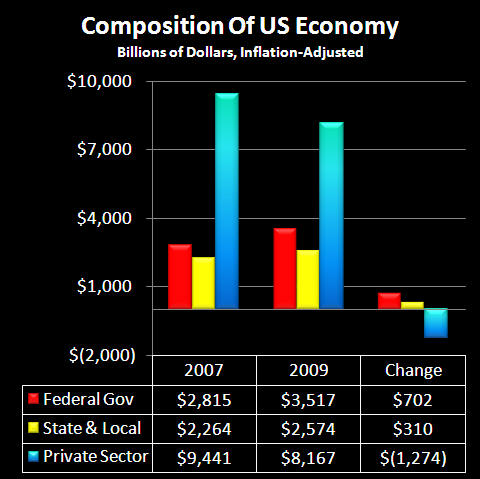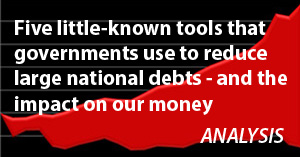Bullets In The Back: How Boomers & Retirees Will Become Bailout, Stimulus & Currency War Casualties
By Daniel R. Amerman, CFA
Overview
Currency wars have their victims, much like military wars. What differs is who the victims are and what the casualty rate is. In a military war, the casualties are usually under age 25. Even in a deadly campaign, most soldiers are not victims because they are in support capacities.
The age of the casualties in a currency war is upside down compared to military war, because the worst of the damage is inflicted on those above age 50. Moreover, it is not just a few, but almost everyone who is on the front lines, and thus almost all become a casualty.
The latest financial headlines may seem arcane, with a vocabulary that is difficult to grasp, but the bottom line is unavoidable – the United States government and the Federal Reserve, in a belated defense of the fundamentals of the US economy, have effectively declared their intention to destroy the life savings of older Americans and devastate their future standard of living. It is the necessary "collateral damage" and all.
That may seem to be a wild assertion, but unfortunately, this financial devastation is the obvious implication of the Federal government's choice of strategy in attacking the overvalued US dollar, as this article will illustrate. We will connect three basic dots - and show where and how the bullets will be hitting.
The major events may be beyond our individual control, but the degree of devastation and the implications for our personal lifestyles is very much under our personal control. It is economic ignorance that will be inflicting more casualties in this war than any other factor, and thus our best personal defense is education.
A Gaping Hole In The Economy, Currency War & Creating Money
We will start with three reality checks, each of which is quickly summarized in a paragraph or two below, with a link to a much fuller explanation in other articles. The first reality check is that despite what you have been reading in the headlines, the United States is not in a "jobless recovery". Quite the contrary, the US private economy has a gaping hole in it that enormous amounts of stimulus spending by the government has been trying to cover over. Even when we use (suspect) official government statistics, you can see a better picture for what the true state of the economy is in the graph below (from my previous article "Soaring Government Spending “Crowds Out” Private Investment Returns"):

http://danielamerman.com/articles/Crowding.htm
Between 2007 and 2009, the private economy - which creates the real wealth in the US - effectively collapsed, and it still has not recovered. We're talking about $1.3 trillion of the private-sector economy that has been wiped out and hasn't come back. What has patched this over has been frantic government efforts to create an artificial economy through "stimulus" spending and other means. The depth of the crisis has been temporarily masked through creating an artificial stimulus economy that is funded by the creation of artificial money.
The second key item that needs to be understood is that the United States of America has essentially declared war again – this time against the rest of the world. It is a defensive campaign - and from Asia, to South America to Europe, the world is none too pleased. The fundamental reason for this currency war, is that the US private economy can't grow out of its $1.3 trillion hole so long as the US dollar is "strong".
Thus, waging currency war has become a necessary evil now that the US government has (finally) come to the defense of the US economy. To do so, the government must knock down the price of the dollar relative to other currencies. The intent is to stop subsidized foreign goods from flooding the US market, and open the doors for US exports to rebound as well. For more than a decade, US workers had been competing with one hand tied behind their back because of an artificially expensive dollar - and untying that hand is essential for any real recovery.
The bizarre spectacle of the US government threatening its own currency has been quite successfully reducing the value of the dollar (at least until the counterattacks began, with Japan's assault on the yen being the most notable), but at a terrible price. The US government is effectively creating artificial money equal to about 9% of the overall economy. In the short term, this both provides a semblance of patching up the hole in the US economy, and very convincingly shows the rest of the world that we're willing to destroy the value of our own currency to gain competitive advantage in trade.
As we will discuss herein, yes, the dollar must be weakened - but it doesn't need to be destroyed, and a reckless strategy is being pursued that risks the annihilation of not only the dollar but the future standard of living of all of us.
The Bullets In Your Back
Let's take a look at the obvious effects of currency war. Walk down the aisle of any Wal-Mart, Costco, Target, Best Buy, or most any discount or department store in the US. What you will see is aisle after aisle of clothes, shoes, toys, kitchenware, appliances, and just about anything else that you could ever want or need, that used to be at least primarily manufactured in the United States 20+ years ago - but no longer is. As a result of more than 10 years of currency manipulations directed against the US, against which the US did not defend itself, we have taken the production of the base essentials of life and moved it overseas.
While a return to genuine free market prices and having real goods and services produced by US workers would strongly benefit the US economy, it comes with a necessary cost – the price for these goods inside the US has to go up because the artificial subsidy has been knocked away. So the price of waging currency war is paying more for everything that is currently being imported into the US. The bullets being fired by the US government in its attempt to lower the value of the dollar - are heading straight towards your back.
Every time you pay more for a new pair of pants, a shirt or blouse, or pair of shoes, you're taking a bullet.
Every time you buy a new TV, clock radio, DVD player, or toaster oven – you'll take a bullet.
These bullets we have been taking are not only for luxuries, but for the very day to day necessities of keeping warm, transportation and keeping food on the table. And if you are an older American, then hopefully you can clearly see how this currency war may be one of the major determinants of your personal standard of living for years and even decades to come.
Next, let's consider the cost of the bailouts. Hundreds of billions of US government dollars have been given to major financial corporations, even while almost $2 trillion in newly created money was transferred from the Federal Reserve to financial institutions in the Fed's private manipulation of US markets. When we see record bonuses at some investment banks, even as the trillions are manufactured out of the nothingness, we're also seeing waves of bullets hitting all of us in the back.
Those who will help rebuild the American economy through their productive jobs over the decades to come will likely do so in exchange for a decent standard of living. It may not in some ways be as high a standard of living as that enjoyed by their parents, but because they are working and producing real goods, they're going to be able to keep a good chunk of what they produce.
The worst of the danger threatens the older people who have been relying upon financial assets and promises from governments and corporations to provide for their future standard of living. The devastation of the value of the dollar, as well as the ripple effects on pensions and governmental spending means that for these people, their standards of living are all too likely to be more or less in freefall.
The Boomer & Retiree Catch-22
When we add up all of the bullets, and consider the number of victims, we realize that these aren't rifle shots - but rather the work of a machine gun. As the US government and the Federal Reserve swing the machine gun back and forth, repeatedly hitting the long line of tens of millions of retirees and Boomer investors in the back, and destroying the savings, dreams and future standard of living for all of those good people, it would be a natural reaction to scream out: "Stop that! Stop right now!" And then try to salvage what we can.
Most of the bullets are unnecessary and rash risks taken by a reckless government, and it is in the urgent national (and international) interest to find a way of stopping the machine gun. Unfortunately however, we can't completely stop the assault on the dollar. The heart of the dilemma is that the US economy itself is in very bad shape. We're effectively in a depression, and have been in a depression for a long time now, even if the government has so transformed the way in which unemployment and inflation rates are calculated that it can declare not only that War Is Peace (per Orwell), but that this deepening depression is just another recession that has already ended.
For close to 15 years now, the US standard of living has been a dream. We have become a nation whose real economy has been hollowed out, by allowing China and other nations to manipulate their currencies and flood the US markets with their goods at artificially low prices. Becoming a debtor nation that borrows from other nations to pay for goods that we could not otherwise afford has allowed us to live with a higher standard of living than we otherwise would have, much like a household that subsidizes its lifestyle by running the credit card balances ever higher. And there is no way to get our real (private sector) economy out of depression without US workers being able to fairly compete against international competition.
If we can't compete, then there isn't a real economy for us to fall back upon. Without a healthy real economy, there is nothing real that we can consume when we cash in our paper retirement promises. Indeed the weaker the real economy, no matter how much you shuffle the paper claims and promises around, the less real goods and services there are to go around for the older segments of the population who are hoping to either be retired, or at least to not have to work quite as hard in their later years.
That is the Catch-22 facing the older generation. We're already standing on the front lines. Our own government and central bank are already machine-gunning us all, and we can only anticipate heavier gunfire over the coming years.
This is all too likely to have catastrophic implications for the average older saver, and again, most of the damage is unnecessary. It is not all unnecessary, however, because if we don't weaken the dollar, then we face even greater impoverishment - and you really, truly do not want to be a retiree in a multi-decade depression. Even if pandering politicians give you endless paper claims, an impoverished nation simply can't provide the real resources to its older citizens to honor those paper claims. The Baby Boom and current retirees are caught in a terrible dilemma, and for the average Boomer or retiree, tragically, there is no magic wand to wave that can make the problems go away. And ignoring the problems in the hope that these terrible issues will just go away - only guarantees that our personal outcome will be to achieve victim status.
The Divergence
To fully understand why what has been promised to us in retirement never will arrive for most of us, we have to accept the hard truth that those dreams never were real. It doesn't matter how many professors and prestigious investment firms assured us that this was in fact the case - it has been nonsense the entire time. To illustrate this point, I wrote a book in 1992, titled "Mortgage Securities" that was published in 1993. On page 59 of this book, I wrote in large, double sized letters:
"Stock performance comes from the economy, not numerology."
It is economic growth that determines the real wealth that we all enjoy from our long-term investments. Future wealth for retirees will not be based on the numerology of using a carefully selected series of historical financial statistics and compounding them without limit or connection to the real world (as was and still is the norm). In concluding Chapter 6 of that book, I wrote the following:
"High Dividends Are Both Crucial And Long Gone
Looking at the impressive 406 to 1 total return that could have been achieved by purchasing a market portfolio in 1925 and selling it in 1988, we find that 95% of this ending wealth is based upon dividends and reinvested dividends. We also find that between 1930 and 1950, stock dividend yields averaged approximately twice the rate paid by Treasury bonds, that long-term bond yields did not exceed average dividend yields until 1959, and that the two yield types remained reasonably close throughout the 1960s.
Given the paramount importance of reinvested dividends and interest payments in determining ending wealth, and given that modern dividend levels are consistently between one third and one half of long-term bond interest levels, it is patently absurd to use reinvested dividend models that incorporate data from prior to the 1970s in order to judge the likely future performance of stock portfolios".
Even as I was writing those words over 20 years ago, it was plainly obvious (to me) that the US retirement financial industry - as well as what passed for consumer financial education - were based on a deeply flawed, "patently absurd" model, that was relatively easy to disprove.
While my 1993 book was advertised as an "Institutional Bestseller" by its publisher for a year afterwards, and led to a couple of years of speaking to audiences of financial professionals on a nationwide basis, I never was able to get it in the general bookstores or catch the attention of the mainstream media. That's too bad, because the book had not actually been intended for professionals, but to warn and help the average "lay" person, a mission that I continue all these years later.
The situation even by 1993 was that in our collective expectations for long-term investment, whether in our IRAs or pension funds, the entire nation (and much of the world) was betting their collective financial future on a theory that essentially said a 2% average annual rate of real growth could be turned into 8% compounded wealth for a nation as a whole. A more detailed explanation of this fundamental problem with traditional financial planning can be found in the 10 minute video linked below:
http://danielamerman.com/Video/MMM.htm
In the late 1990s the situation got much worse. It was at that time that we began the true hollowing out of the US economy with the extraordinary financial growth of China, even as the values of our paper wealth grew ever higher and higher. Year by year, the divergence between compounding paper wealth and an increasingly unhealthy real economy grew wider and wider.
What we saw during the turn of the 21st century collapse of stock market values was only a partial convergence between dreams and reality. Unfortunately the remaining convergence is still ahead of us, and it is likely to get much worse as more and more people across the country - and more and more pension funds and pension fund sponsors such as state governments and corporations - are forced to recognize that real wealth cannot grow faster than the real economy.
Absent a fantastic surge in real economic productivity, there simply is no realistic hope for us to be able to live our lives in a manner that is based on the false dreams of the past. And to return to reasonable economic growth requires that the US must become competitive again and grow real jobs to generate real goods and services, a portion of which can then go to people who are no longer in their working years. This, unfortunately, means returning the dollar to competitive levels on a global basis, regardless of the damage that is done to good hard working people who have tried to do responsible things for themselves and their families for their entire lives.
An Unnecessary War
We didn't have to be in this situation. The US government didn't have to preemptively surrender the US economy to currency manipulation, predicated upon the thoroughly naïve academic theory of globalization that ignored currency manipulations. That's really the heart of the problem: the currency war has been going on for well over a decade, and the US simply hasn't been defending the jobs of US workers.
The banks didn't have to do extraordinarily reckless things in the pursuit of short-term profits, causing the pain we're all feeling today. We didn't have to dismantle the Glass-Steagall restrictions that protected the banking industry from itself from 1933 to 1999, nor did we have to decide that the most dangerous financial instruments ever devised - derivatives – could be created by federally insured institutions on an unlimited basis in a regulation-free zone. The financial industry didn't have to push a "patently absurd" long-term investment model.
There never were going to be tens of millions of immaculately groomed and coiffed, silver-haired Boomer couples spending their retirements sipping fine wines on the verandas of their lakeshore homes, funded by the simultaneous sales of investments from their plush retirement portfolios - no matter how many billions of advertising dollars the financial industry spent (and is still spending) encouraging us to believe in the fantasy.
However, we could have had a much stronger real economy at this point, albeit at a price of not having partied it up with our national standard of living for the last 15+ years, using borrowed money. We could have had far sounder, more modest retirement strategies that were based on the real economy rather than numerology and fantasy-based exponential compounding. We could've had more real goods and services with no collapse of illusions, or collapse of the value of the dollar, or collapse of the future standard of living for older Americans.
This didn't have to happen.
But today – we are where we are.
The core issue is that dollar-denominated savings are fairly meaningless anyway, except as claims on a real economy that is severely wounded and still reeling. "Saving the dollar" merely prolongs and deepens the depression. It is the real economy that must be saved if people are going to enjoy a standard of living based on real goods and services. The dollar needs to be weakened, which will drop standards of living back to reality even as the US stops being a debtor nation, and stops consuming what it can't pay for. However, a painful but necessary controlled weakening of the dollar needs to be clearly distinguished from the annihilation of both the dollar and the future standard of living of older Americans, events that are the all too probable outcome of the government's current reckless strategy.
Solutions: Frank Honesty
To find solutions as a society, we need to start with some basic honesty and common sense. We need to use this common sense to connect the three not particularly controversial dots listed below:
Dot 1. Directly creating money at a fantastic rate from thin air, which you can call monetization or "running the printing presses", has a high chance of producing a high rate of inflation. Viewed over the long term and from the perspective of most economic observers, there's nothing particularly controversial about that.
Dot 2. High rates of inflation tend to disproportionately impoverish the retirees and older savers. Again from an economist's perspective, there is nothing controversial about that statement. Most money is held by the older part of the population, people who earned it over their working years, and who have very limited or no years left in the work force to replace that money with the new and devalued money. Conversely, the young don't tend to have much savings to be destroyed, but they do have the decades of their peak earning years ahead of them, and they will be paid with more of the new devalued dollars. So destroying the value of money disproportionately impoverishes the old relative to the young.
Dot 3. Stimulus plans, bailouts and currency wars are all disproportionately paid for in real terms by the long-term impoverishment of older citizens relative to the general population.
Connecting dots 1, 2 and 3 is not difficult. It is basic economics. It is common sense. Yet unfortunately it is currently understood by so few. But if this common sense 1-2-3 connection of the dots were to be more widely understood by older Americans, then it would lead to a radical, perhaps even revolutionary change in current American politics. If people were to realize what was being done to them, they would come out in mass numbers to try to protect what's left of what they have.
To get to a better place, we have to first stop the lying. Let's take a look at the body bags as they come in. Let's count the casualties in terms of the spending power of older Americans to pay for all of these programs. We need everybody to be understanding what is happening. That there is a massive hole in the economy, that finding the answers won't be easy, and that it will be painful for most of us.
What honesty offers is the potential to transform the narrative. The nation needs to look at the real costs and must understand that never-ending stimulus money is not manna raining down from the heavens, thanks to those very generous politicians, but is straight up theft of the future standard of living of most older Americans. This facing of reality can then lead to some very controversial but necessary debates as we determine what needs to be done, and how much damage will be done, and who will bear it as we try to reboot the real economy and reclaim prosperity.
What would not be controversial (for the average citizen) is what would happen to the explicit Treasury bailouts of the major banks that have been authorized by Congress, and to the far larger bailouts that the Federal Reserve has been doing on an essentially covert basis. What is allowing this to happen is a gross distortion of the dialogue. Most of the population does not understand what is being purchased or how it is being paid for - with a likely reduction in their day to day standard of living for decades.
We also need to keep in mind that while not identical, there are equivalents of this situation with other nations around the world. Stealing from the older segment of the population to bail out, protect and increase the bonuses of politically connected insiders is not just an American problem, it is a global problem.
Solutions: Stop The Victimization
When I read the mainstream financial analyses of what people should do in these perilous times, I sometimes feel like I'm watching the old American TV series "The Twilight Zone". When I look at the professional financial media – it is clear that the old models have been collapsing around us for years now. The US economy is badly wounded and bleeding internally.
Yet, when I read the investment advice that is given to the average American, nothing is questioned, and it is as if none of this has occurred. We're in this alternate universe where everything is cheerful and just the way it's always been and we need to have a balanced stock and bond portfolio with perhaps just a few changes for the current environment, but nothing fundamental really needs to change. There was a little bump in the road, but the recession is now coming to an end, so we just need to keep following the same instructions, and keep sending our savings to Wall Street while ignoring the prices we pay, and ignoring the economy around us, because the magic power of wealth compounding will take care of us all. Hard to believe – but that is still the state of things, even if it grows more frayed at the edges every day.
Let me suggest that this is an absurd approach. As I point out in my (previously linked) article "Soaring Government Spending “Crowds Out” Private Investment Returns", stock valuation is predicated not on current profits, but on steady increases in future profits. We have a gaping hole in the US economy that is being temporarily papered over with the creation of new paper money. This is a situation that is already approaching the endgame. We have a manipulated institutional market that an increasing number of small investors have been abandoning every year.
What is much worse are bonds of any kind, as well as keeping too much money in checking or savings accounts. Yet, keeping a substantial portion of your life savings in bonds is still the conventional advice when it comes to long-term financial planning for older Americans.
What this ignores is that we now have an openly and massively manipulated Treasury market, where interest rates are explicitly forced down as a matter of national policy. The reason is that the government does not want free market interest rates. It does not want to pay what rational investors would demand to be paid to tie their money up in bonds or certificates of deposit in these perilous times. So the government artificially forces interest rates down. Which means the Federal Reserve is openly, as a matter of policy, cheating private investors who put their own money into bonds or alternative long term fixed income investments. There is nothing covert about it, yet many people are still blind to this.
Making it even worse is that the bullets are already in the air when it comes to the destruction of the purchasing power of the principal value of those investments. We are in a currency war, trying to restart the US economy, and the weapon that our leaders are wielding is the threat to destroy the value of the US dollar. Yet we have some of the lowest interest rates in all of US financial history. This is an extraordinary mismatch, and it means that private investors who are coming in are getting played for suckers by the US government.
Theater Of The Absurd
We are at a bizarre point in financial history that can best be described as the Theater of the Absurd. Even if the diplomatic doublespeak is careful not to use the exact words, the US government is saying to the rest of the world: "Voluntarily agree to let us produce a bigger share of the world economy, thereby reducing our unemployment rate, or we will destroy our own currency if we have to, so we can undercut your prices and take a bigger share anyway."
Meanwhile, Wolfgang Schauble, the Finance Minister of Germany, furiously lashed out at the actions of the US government when QE2 was announced, saying the results would be "horrendous". He stated that he believes the US is in a "helpless" situation, and it won't do any good anyway. In other words, the US should just lie there and take it. To have Germany so publicly and almost contemptuously dismiss the wounded debtor nation that is the US as being "helpless" shows how rapidly the world is changing - and how the Germans are no less delusional than the Americans, when we consider the equally toxic underlying fundamentals of the debt-ridden European economy.
Even former Treasury Secretary Robert Rubin, stated that the risks being taken by Bernanke put the US in "terribly dangerous territory", even as he warned of a potential "implosion" in the bond market. Rubin, who has also been co-Chairman of Goldman Sachs as well as temporary Chairman of Citibank, is arguably one of the central architects of the programs that led to the current fiasco, and that even he has completely lost faith and can plainly see the madness, is quite telling.
And yet the orchestra plays on, with some of the lowest interest rates in US financial history, as well as the placid smoothness of openly and massively manipulated markets.
Solutions: Getting Your Savings Off The Front Lines
To help us understand how to find practical solutions, let's return to our currency war frontline metaphor, and picture an endless line of older savers and investors, all facing forward, taking round after round in the back as their own government works the machine gun up and down the line. The solution?
Get out of the line! Look left and look right at the other members of your unit (i.e. your friends & family), yell "I'm out of here!" to any who will listen, and... "Run like hell"! There is no dishonor in being a currency war deserter, the dishonor is that the war exists in the first place.
How do you get out of the long line and dodge the bullets?
As a financial author, Chartered Financial Analyst, MBA, and former investment banker (in the 1980s) who used to structure some of the world's most complex securities, I've been looking at these issues for a very long time.
First, from a financial professional's perspective, so long as you ignore taxes, then surviving and beating inflation is the easy part. "Buy gold", and "buy silver" are obvious solutions, and there are a number of other ways that seem to dodge the bullets, so long as we don't include taxes or the broader economic and financial context. Substantial investments in gold and/or silver can be essential portfolio components, but not by themselves, because the simple solutions fall apart when you include taxes, as illustrated in irrefutable, step by step detail in the article linked here:
Where things grow challenging, even for highly skilled professionals, is when one looks at the bigger picture, and considers how three distinct elements work in combination. The first element is that there is a huge hole in the economy, but asset bubbles are still being maintained as a matter of government policy. That means that we can expect the real (inflation-adjusted) value of most investment assets to plunge at some point.
Next we have the element of inflation destroying the value of money, simultaneously with the value of those assets being destroyed.
Our third element is government tax rates that can be expected to soar upwards and ensure that simplistic attempts to dodge the inflationary bullets will be defeated, with the government taking not only all of the profits, but much of your (inflation-adjusted) starting net worth as well.
As a financial professional, I refer to this three way combination as simultaneous monetary (price) inflation, and asset deflation (in purchasing power terms) in an environment of inflation taxes. An article which better explains these issues is available at the link here.
I believe that understanding how these three factors interact - the destruction of the value of money, the destruction of the value of investment assets, and rising tax rates - is going to be the single defining test that will distinguish who comes through these years of turmoil with their net worth intact (or even enhanced) versus a far larger number of investors who face financial devastation. When you do what very few investors do, and look not at the glittering facade of wealth, but instead examine the purchasing power of what you have left after taxes - in other words, you look at net worth on both an after-inflation and after-tax basis - then not only do the conventional personal finance strategies fall apart, but so do the most popular contrarian investment strategies. The world is more complex in its unfairness than even most cynics fully recognize, and most investors who think they are prepared for the destruction of the dollar are really just prepared to hand over most of their inflation-adjusted net worth to the government.
There are personal solutions. There are other schools of investment finance that can handle what is coming, methodologies that are used by the most sophisticated investors in the world - but they are quite different from the simplistic strategies that dominate both the mainstream and contrarian flavors of personal finance.
The first step is to see the bullets that are coming at you. Once you see the bullets - you have to do something that most of the victims will never do, and that is take personal responsibility for your own future in a deeply unfair world. Neither the government nor Wall Street are going to bail you out of the mess they have created, and the conventional financial "wisdom" isn't going to do it either. You're on your own, and that means rolling up your sleeves and taking individual actions to protect what you and your family have.
Once you've decided to accept this personal responsibility for your future, then you have to be open to changing how you see money and your investments. To find personal solutions, you have to be open to education leading to paradigm change. When you have that education, and have changed the "lenses" through which you view money and investments - then you can also start to see the professional grade tools that can be used to handle the simultaneous destruction of the value of money, and the value of assets. Surprising tools found in places you never expected, often without even calling a broker, that can be accessed by most people, and used in a dynamic sequence for the stages of crisis - when we step outside the usual personal finance boxes.
Do you see the bullets flying?
 What you have just read is an "eye-opener" about just one of the ways in which a rapidly shifting world is removing the foundations beneath conventional investing - even while most investors continue to follow the traditional strategies, unware of just how much the financial playing field has changed.
What you have just read is an "eye-opener" about just one of the ways in which a rapidly shifting world is removing the foundations beneath conventional investing - even while most investors continue to follow the traditional strategies, unware of just how much the financial playing field has changed.
 Another "eye-opener" tutorial is linked here, and it shows how governments can use the 1-2 combination of their control over both interest rates and inflation to take wealth from unsuspecting private savers in order to pay down massive public debts.
Another "eye-opener" tutorial is linked here, and it shows how governments can use the 1-2 combination of their control over both interest rates and inflation to take wealth from unsuspecting private savers in order to pay down massive public debts.
 An "eye-opener" tutorial of a quite different kind is linked here, and it shows how governments use inflation and the tax code to take wealth from unknowing precious metals investors, so that the higher inflation goes, and the higher precious metals prices climb - the more of the investor's net worth ends up with the government.
An "eye-opener" tutorial of a quite different kind is linked here, and it shows how governments use inflation and the tax code to take wealth from unknowing precious metals investors, so that the higher inflation goes, and the higher precious metals prices climb - the more of the investor's net worth ends up with the government.
 An "eye-opener"
tutorial of yet another kind is linked here, and it shows how much of what the public believes to be true about stock market history - is merely an illusion, which also just happens to facilitate the redistribution of wealth.
An "eye-opener"
tutorial of yet another kind is linked here, and it shows how much of what the public believes to be true about stock market history - is merely an illusion, which also just happens to facilitate the redistribution of wealth.






If you find these "eye-openers" to be interesting and useful, there is an entire free book of them available here, including many that are only in the book. The advantage to the book is that the tutorials can build on each other, so that in combination we can find ways of defending ourselves, and even learn how to position ourselves to benefit from the hidden redistributions of wealth.


















